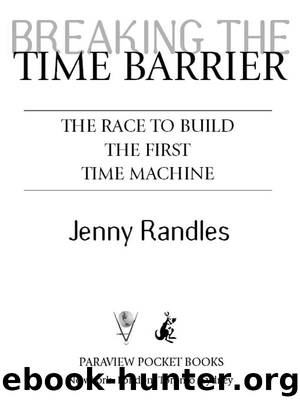Breaking the Time Barrier by Jenny Randles

Author:Jenny Randles
Language: eng
Format: epub
Publisher: Paraview Pocket Books
Published: 2005-07-15T00:00:00+00:00
1992
Chronology
Protection
None of these developments did much to help Stephen Hawking square the growing number of potential time machines with his own thinking. The closer we seemed to be coming to breaking the time barrier, the deeper his frustration grew. Though some once skeptical scientists were beginning to accept the inevitability of time travel, Hawking was not so easily persuaded and led the rearguard defense of the principle that cause always had to precede effect. The question was—how could Hawking convince his colleagues otherwise?
Hawking proposed a way that time travel might be blocked from reaching practical fulfillment thanks to what was then an unknown rule of the universe. Once it was found, then it would show why time travel could never happen, even though all indications seemed to suggest otherwise. Hawking called this mysterious property of nature “chronology protection.”
This idea was just conjecture, he admitted, not proven fact, but must exist in the scheme of things if we are to stop wormholes from causing mayhem all over the universe. 55 If the chronology protection rule doesn’t exist, then countless advanced civilizations ought to be roaming the universe and causing temporal interference to suit their needs. Indeed, a sufficiently ruthless species could simply have used these time tunnels to eliminate all opposition to their domination and be in total command of the cosmos.
Clearly there was no sign of any such time travelers, which further demonstrated to Hawking that some kind of blocking strategy was probably at work in nature to effectively bar time travel from happening. And many scientists agreed. Even in the early 1990s the prospect of someone building a time machine and upsetting centuries of thinking about the laws of nature was still anathema. Heartened by this new idea, a number of researchers actively set out to prove that Hawking’s negative approach was correct.
This introduced a growing battle between those who were eager to make time travel work and scientists sure that Hawking’s chronology protection law must be out there waiting to be discovered. Jerome Gauntlett of Queen Mary’s College in London quickly challenged Hawking’s speculation, when he calculated what the universe would be like if there were five special dimensions instead of the four that Klein had revealed in 1926. This additional dimension provided useful resolutions to complex mathematical problems, but as a side effect quadrupled the versions of the universe in which time travel would be a common occurrence. If Gauntlett was right, then time travel was the rule, not the exception.
Unwilling to accept this result, Peter Horava at Berkeley in California probed deeper and suggested a way to overcome it. His argument basically involves seeing reality as a holographic projection—with our limited dimensional senses just observing a reflection of this higher fifth-dimensional reality. This inherent limitation in our perception of reality creates a number of illusions, which are nothing more than reflections of the full picture rather than the full picture itself. 56
It’s possible to visualize this by recalling that a shadow on a wall is a two-dimensional projection onto a flat surface of what is in truth a three-dimensional object.
Download
This site does not store any files on its server. We only index and link to content provided by other sites. Please contact the content providers to delete copyright contents if any and email us, we'll remove relevant links or contents immediately.
The Complete Stick Figure Physics Tutorials by Allen Sarah(6638)
Secrets of Antigravity Propulsion: Tesla, UFOs, and Classified Aerospace Technology by Ph.D. Paul A. Laviolette(3450)
Thing Explainer by Randall Munroe(3328)
The River of Consciousness by Oliver Sacks(2992)
The Order of Time by Carlo Rovelli(2714)
I Live in the Future & Here's How It Works by Nick Bilton(2524)
How To by Randall Munroe(2476)
A Brief History of Time by Stephen Hawking(2474)
The Great Unknown by Marcus du Sautoy(2186)
What If?: Serious Scientific Answers to Absurd Hypothetical Questions by Randall Munroe(2170)
Blockchain: Ultimate Step By Step Guide To Understanding Blockchain Technology, Bitcoin Creation, and the future of Money (Novice to Expert) by Keizer Söze(2138)
Midnight in Chernobyl by Adam Higginbotham(2078)
Networks: An Introduction by Newman Mark(1998)
The Meaning of it All by Richard Feynman(1909)
Easy Electronics by Charles Platt(1864)
The Tao of Physics by Fritjof Capra(1850)
When by Daniel H Pink(1777)
Midnight in Chernobyl: The Untold Story of the World's Greatest Nuclear Disaster by Adam Higginbotham(1775)
Introducing Relativity by Bruce Bassett(1755)
